When is it too cold for kayaking, you ask?? The answer really depends on what type of paddling you enjoy. Many of us consider kayaking to be a summer-only activity and are more than content to hang up the paddling gear for the season when things start to get cold outside. Others will paddle on to brave the colder waters in order to experience the fall foliage or a quiet day on the lake after the exodus of vacationers. For those of us who are mesmerized by a snow-covered beach-scape the season tends to linger on until our favorite waterways freeze over!
So what if I were to say that it’s NEVER too cold for kayaking? Clearly, this bold statement is a matter of semantics. Yes, we can paddle our kayaks so long as the water temperature is above freezing. However, the fact that we can do something says nothing about whether we’re prepared to do it safely. The goal of this debate is to examine the unique challenges that cold water presents to the paddler and discuss some strategies that can help us to safely extend our paddling season.
Kayak Dave’s Take:
I’m going to open this discussion by coming right to the point: Cold water, regardless of the time of year, is the single most dangerous thing that a kayaker is faced with when they shove off from shore. Period. Immersion in water colder than 60°F can lead to the rapid development of hypothermia and put you in dire straits in short order. The colder the water (and air) temperature gets the faster this trouble will find you. The best way to deal with cold water is to respect it and take measures to mitigate the risks of immersion.
I’ve always taken a very conservative approach when it comes to paddling on cold water and my strategy centers on dressing for immersion. I recently covered this topic in depth in a post entitled “How to dress appropriately for cold water paddling.” In this post, I discussed using a three-layer clothing system as a way to ensure that you stay warm and dry while paddling and to best protect yourself should you end up in the frosty drink. In short, an ideal clothing system for cold water paddling consists of a moisture-wicking base layer, an insulating mid-layer, and a breathable, water-proof shell layer. Once you add a hat, neoprene gloves, and booties you’ll be ready to get under way. Granted, you may feel like (and be mistaken for) an astronaut in this get-up. Like space, cold water is an inhospitable environment and you’re always better off being prepared for immersion rather than being sorry it happened!
We should all appreciate the importance of wearing a PFD while paddling regardless of the time of year. In winter months, wearing a PFD becomes even more important. One of the greatest dangers of cold water immersion is phenomenon known as “cold shock” where an involuntary gasping reflex can be incited by rapid exposure to the cold water. Cold shock, not hypothermia, is the leading cause of cold-water drowning during the first minutes of immersion. A PFD will help you survive the initial exposure and give you the time to recover from capsize. Not only is wearing a PFD while paddling on cold water the smart thing to do it may also be the law. (Check local listings!)
Unfortunately, all of the proper clothing and safety gear in the world will not make you invincible to the dangers of cold water. In order to further protect ourselves we must augment our concepts of “acceptable risk” in some fundamental ways. For example, I’ll often enjoy a solo paddle during the summer months but when the water gets cold you’ll rarely see me paddling without a trusted partner. Furthermore, I challenge those interested in cold water paddling to carefully examine their limits (trip distance, exposure, max conditions, ect) and remain hyper vigilant of changing conditions while on the water. In the summer, 15-20kt winds and 3-4ft seas may sound like fun and warm water allows for a larger margin for error when surprises pop up. In the winter these same conditions can be brutal and quickly turn dangerous if they catch you by surprise. My best advice here is to dial it back from 11 and save the epic moments for a warm water day!
By following these simple tips you’ll be well on your way to enjoying safe paddling trips throughout the fall and beyond!
–Kayak Dave
Boreal Alvik’s Take:
My hope is that this brief article will encourage less experienced paddlers to consider exploring what cold-water safety involves. This is a case where basic knowledge will help to keep you safe and can save your life. There are many common maxims floating around that while partially true can also lead to a false sense of security. Let’s consider four of these “cold water proverbs” and examine how they impact your safety:
The first maxim of “Cotton Kills” was a lesson I learned in my first year of paddling. Wet cotton quickly pulls body heat away from your core and extremities. Wearing layers of polypropylene, polyester fleece, and/or wool can help wick moisture away from your body and offer a much-needed insulating effect. It will help offset and delay the dangers associated with Hypothermia, but have little effect upon the physiologic functions of Cold Shock. Wearing insulating headwear may partially address the issue of Cold Shock. Insulating headwear can be uncomfortable and sweaty at times; but that thin neoprene balaclava may very well save your life.
Have you ever had the experience of taking a shower when the water suddenly changed from comfortably warm to very cold? Can you remember that almost involuntary gasp of air that you take in at that moment? Now, multiply that experience exponentially and you have a sense of what happens when your very warm head and chest area are suddenly immersed into that cold seawater.
The second maxim is that paddling close to shore allows the capsized paddler the option of a few minutes swim to shore. While it may be within your summertime skill set to comfortably swim 30 yards and only be a little out of breath; it is not the same in 40 to 45 degree water wearing a PFD and heavy water saturated clothes. It is not the same when numbness and a progressive lack of coordination and impaired judgment begin to present themselves within a relatively short period of time.
The third thing to consider is that “alarming indicators” do not diminish but tend to grow more serious fairly quickly as time progresses. For example, exposed hands will grow numb within a matter of a few minutes when showered by the spray blowing back from your bow as you pound through a bit of chop on a windy day. Attempts to perform even simple movements like unzipping the pocket on your PFD to more readily gain access to your whistle now become as challenging as trying to do that same maneuver on a summer day wearing winter mittens.
The fourth error in judgment is to assume that as many people are around as there are when the air and water temperatures are more inviting and comfortable. Take a minute to look around you on a pleasant November day. How many boats do you see in the harbor? How many folks are winterizing their boats in the boatyard or marina that you can yell to over the blowing wind? How many people are out fishing off the rocks or from a skiff? …The time that you need people the most, may very well also be the time when there is likely to be the fewest around.
Kayaking is in large part about self-sufficiency; the essence of cold water safety and survival. To paddle in conditions that you have the demonstrated and practiced skills to be safe in and to not be dependent on others to save you is to be self-sufficient.
A good resource to learn more about Cold Water Safety can be found at the Atlantic Kayak Tours website
Paddle safely
B.Alvik
Alex’s Take:
Both Kayak Dave and Boreal Alvik left us with some great suggestions regarding winter paddling. It is during the fall and winter months where we begin to see a rise in canoe and kayaking drownings. While kayakers are prone to serious injury year round, it isn’t until early fall through late spring where people are most at risk for cold water related incidents. Don’t be fooled by the air temperature or the beautiful sunny skies. Water as warm as 60°F can initiate cold water shock where the body can become completely incapacitated within a matter of minutes.
To avoid being redundant and recapitulating Dave and Boreal’s earlier mentions, I will just outline an important skill set to know when planning on a cold water paddle. One of the biggest mistakes individuals make after a sudden cold water immersion is to act upon the desire to swim back to land. While this seems like the most logical and most instinctual decision, swimming, even over a short distance can pose a life threatening situation. Strong swimmers have died before even swimming 100 yards in cold water.
If it is not possible to immediately exit the water through either an assisted- or self-rescue, the most viable survival option is to assume the Heat Escape Lessening Posture, also referred to as the H.E.L.P. This position is endorsed by the U.S. Coast Guard and the American Canoe Association as the best method to retain body heat in cold water. Crossing your arms and legs, keeping thighs close together, and letting the buoyancy of your life jacket keep you above water will greatly increase your chances of survival. This position is intended to keep the body insulated and to extend the sudden onset of cold water symptoms until help arrives.
Happy winter paddling!
-Alex


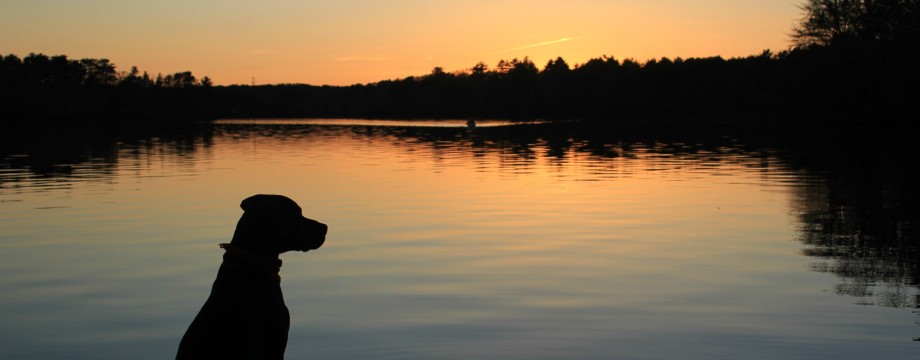
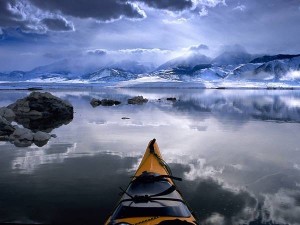
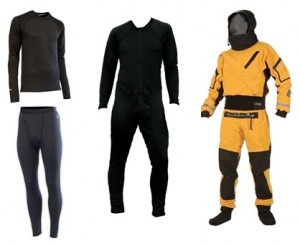

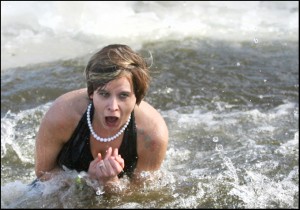
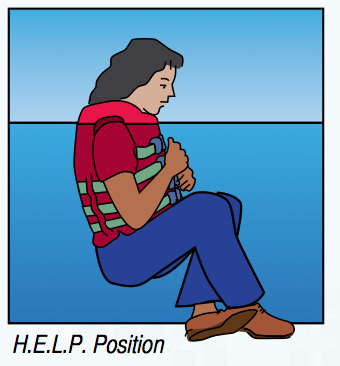
One Response to When is it too cold for kayaking???